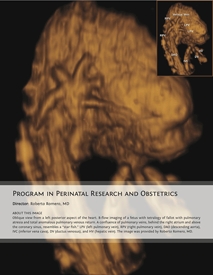You are here: Home > Program in Perinatal Research and Obstetrics
Program in Perinatal Research and Obstetrics
Director: Roberto Romero, MD
The Program on Perinatal Research and Obstetrics (PPRO) conducts clinical and laboratory research on maternal and fetal diseases responsible for excessive infant mortality in the United States. The PPRO focuses on the mechanisms of disease responsible for premature labor and delivery, with particular emphasis on the role of subclinical intrauterine infection and inflammation. The prenatal diagnosis of congenital anomalies is also a major area of interest.
The Perinatology Research Branch was created by Public Law (1993) to address the causes of excessive infant mortality in the United States. The Branch, now called the PPRO, focuses on the study of pregnancy and pregnancy complications, and is housed in Detroit, Michigan, on the campus of Wayne State University and at the Detroit Medical Center. The location is appropriate because of the high perinatal and infant mortality in the city as well as the contribution of ethnic social disparities to adverse pregnancy outcome. The PPRO provides state-of-the-art prenatal care to women enrolled in NICHD protocols and has made major contributions to the diagnosis of congenital anomalies and the understanding of the mechanisms of disease in premature labor/delivery and preeclampsia.
Preterm birth is the leading cause of perinatal mortality and morbidity worldwide. The PPRO defined preterm parturition as a syndrome and determined that at least 25 percent of preterm neonates are born to women with subclinical intra-amniotic infection. The PPRO also provided evidence that many premature neonates are critically ill before birth and proposed that, in the context of intrauterine infection, the onset of premature labor has survival value.
The PPRO also strives to improve the diagnosis and treatment of fetal diseases and congenital anomalies, focusing on the use of three- and four-dimensional ultrasound. The technology has been used to improve the diagnosis of congenital heart disease and to assess the adequacy of fetal growth.



